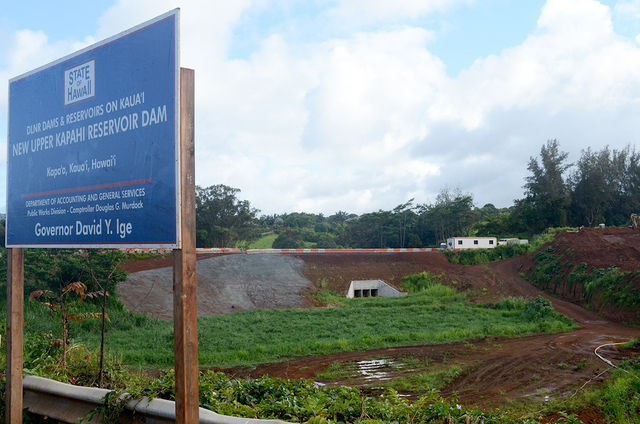KAPAHI — Kainahola Road is open again.
The road, which is a connector route between upper Kapahi and the nearby areas, including the Wailua Homesteads, was closed to allow reconstruction of the road, excavation of the embankment, and construction at the base of the Upper Kapahi Dam, according to county officials. A project to replace the dam was kicked off in 2010.
Now the road traverses in the same location, but there’s a new culvert underneath that allows water to flow downstream.
Lyle Tabata, acting Kauai County engineer, said the dam was breached last summer and the reservoir was drained. Now, the state is working toward constructing a new dam upstream of the old one.
The state’s Department of Accounting and General Services, which is managing the project, didn’t return requests for a status update on the construction of the new dam before press time.
“Kainahola Road is not a heavily traveled road, but it does provide additional road network and route options,” Tabata said.
That’s when the county entered into an agreement with the state’s Department of Land and Natural Resources to breach and remove the original 1910 earthen embankment dam, which stored irrigation water diverted from the Kainahola Stream and Kapaa Stream.
Tabata said the original Upper Kapahi Reservoir was part of the irrigation system for the sugar cane in east Kauai.
“While sugar is no longer cultivated, there remains a need for irrigation water in east Kauai for various agriculture operations,” Tabata said. “However, the demand for water is much lower than it was in the past.”
Currently, the East Kauai Water User’s Cooperative uses the water from the irrigation system.
“Once the new, smaller Upper Kapahi Reservoir is completed, it will become part of the system to provide a smaller amount of irrigation water than was provided by the original system,” Tabata said.
He said water is being provided to users in the Upper Kapahi Reservoir area from the Wailua River, through the extensive ditch system.
Tabata said DLNR agreed to fund the cost of the Upper Kaphai Reservoir Project and the county would fund the cost of the Lower Kaphai Reservoir removal project.
The price tag for the county was $1.8 million, and that money was paid in September 2010 for the removal of the Lower Kapahi Reservoir. He said county personnel have been monitoring the project during design and construction, even though no money was provided from the budget directly for the Upper Kapahi dam construction.
According to the state Division of Public Works, the height of the new dam, once completed, will be about 15 feet lower than the former dam and storage capacity will be reduced from about 110 acre-feet to about 35 acre-feet.





